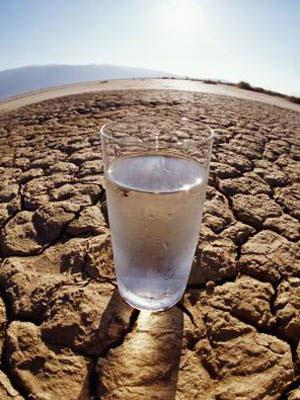
Access to clean sources of fresh water is a growing environmental concern for the international system, and disputes between states over this precious resource may instigate future wars (Ray, Kaarbo 464). Groundwater contamination and leaching are problems associated with cross border flows (Ray, Kaarbo 510) that already contribute to the possibility of armed conflict. Ethiopia must tap into the Nile to meet its water needs, which has consequences for the security of the countries downstream, for example (Schroeder Lecture 17). In general, many factors contribute to regional shortages of fresh water, including geography, population and pollution. In developing states the problem of water contamination is often a result of urbanization and industrialization in the absence of adequate infrastructure to deal with waste (Ray, Kaarbo 467). The issue of sanitation is inexorably tied to economic development. To prevent wars over water the issues of scarcity and purity will both need to be addressed.
Fresh water is a renewable resource that seems almost unlimited, but in the last 70 years its use has increased by 600% (Dense Lecture 13). Increasing food production is a major cause of the accelerated use of water, as two thirds of all fresh water is utilized in the cultivation of crops. (Dense Lecture 13) Egypt, India, and Iran already have water deficits and will likely need to import substantial amounts of food (Flavin 12). China, the world’s most populous country, has experienced a dramatic decline in the water table under its capital Beijing, which has fallen 59 meters since 1965, including 2.5 meters just in 1999 (Flavin 12). Even more shocking for China, the Yellow River went dry for 227 days in 1997 (Dense Lecture 13). In the next 25 years, the number of people living in countries with water shortages is forecasted to increase from 505 million to 2.4 billion (Flavin 12). The risk of armed conflict between states over water resources will become increasingly probable if current trends continue.
Besides the general lack of water due to geography or over use, clean water is unavailable to 1.1 billion people worldwide (Dense Lecture 13). This amounts to 33% of people living in developing countries (Dense Lecture 16), and highlights the correlation between economic growth and its impact on environmental conditions. The cost of environmental protection is too much to bear for countries in the earlier stages of modernization (Ray, Kaarbo 467). Since third world governments usually cannot afford water purification facilities, surface water is contaminated with 90% of the sewage and 70% of the industrial waste in these countries (Dense Lecture 13). Environmentalists are concerned that economic globalization is a significant factor in these sorts of problems, because free traders and emerging market investors ignore the ecological consequences of development (Ray, Kaarbo 510). The environmental organization Friends of the Earth opposed the North American Free Trade Agreement due to the lenient pollution standards in Mexico (Ray, Kaarbo 155). The tension between development and sustainability illustrates the need to form comprehensive plans to deal with both concerns simultaneously.
Pushing for sustainable development would help the third world pursue economic goals without jeopardizing future prosperity (Ray, Kaarbo 477). The United Nation’s Millennium Development Goals (MDGs) include an effort to ensure environmental stability (Ray, Kaarbo 413). Specific to water, the MDGs aspire to halve the percentage of people who lack access to basic sanitation and safe drinking water by 2015 (United Nations 14). Contrary to some environmentalist’s views, economic development itself can help with the reduction of water pollution. Developed states have better sanitation technology, making water born diseases much less common. (Ray, Kaarbo 468) Water shortages are a more difficult problem for poor countries to overcome, due to the implications this also has on agriculture. This makes population control a goal of some water deficit states, such as Egypt and India (Ray, Kaarbo 462). Saudi Arabia, a primarily desert country, has invested heavily in desalination technology to meet its water needs (Mahoney Lecture 18). Sustainable development and investments in innovation are helpful steps to reduce the potential for wars over water.
The depth of the water deficit issue is beyond what I expected. It is difficult to comprehend the Yellow River drying up for almost two thirds of a year. Statistics like this express the urgency of the problem, and convinced me that the possibility for water wars is very real. I also overestimated the viability of some solutions due to the interdependent nature of environmental issues. For example, Saudi Arabia has invested in desalination, but pollution from offshore oil spills contaminates the coastal water sources (Mahoney Lecture 18). I learned that the axiom to think globally and act locally in regards to the water crisis means more than just personal conservation. I must take steps to reduce my water use, but local water preservation has little effect on countries in Africa and Asia. Direct advocacy for the issue through donations to Non-Governmental Organizations or patronage to Multinational Corporations who express corporate social responsibility are globally impactful ways to act locally.
Jared Roy Endicott

Works Cited
Ray, James Lee, and Juliet Kaarbo. Global Politics. 9th ed. Boston: Houghton Mifflin Company, 2008. Print.
Flavin, Christopher. “Rich Planet, Poor Planet.” State of the World 2001. Linda Starke, Editor. New York: W.W. Norton & Company, 2001. Pg. 1-20. Print.
“The Millennium Development Goals Report.” United Nations. Department of Economic and Social Affairs (DESA). New York. DESA, Jun. 2007.Web.

